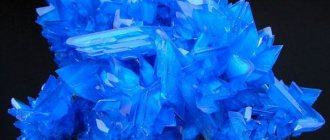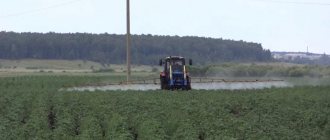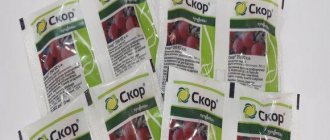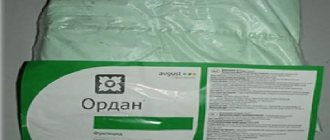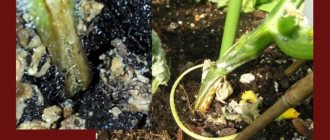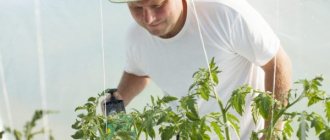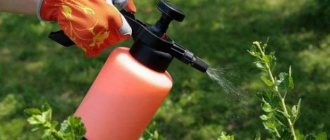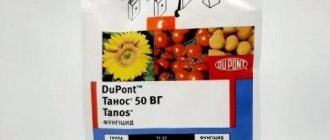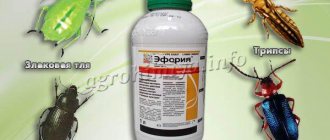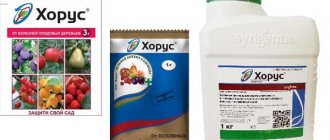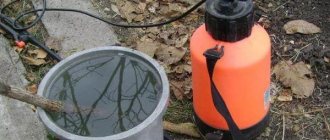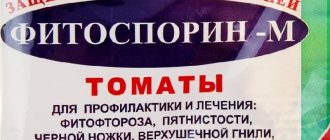Loading…
Loading…
One of the simplest and most accessible fungicides is the drug XOM, instructions for use of which are presented below. Its value lies in the fact that its composition is suitable for garden and ornamental plants, destroys pathogens of fungal diseases and is suitable for use at home. However, it is important to strictly follow the dosage and safety rules when working with the substance - otherwise there is a risk of poisoning.
Content
- Purpose and application of "HOM"
- Composition and dosage form
- Mechanism of action
- Regulations for the use of "HOM"
- Compatibility
- Restrictions and security
- Analogs of "HOM" and preparations containing copper oxychloride
- Advantages and disadvantages of using "HOM"
"HOM" is a contact fungicide with a broad spectrum of protective action. The material contains the purpose, composition, processing regulations, restrictions, compatibility, etc.
Reviews from vegetable growers
According to reviews, the drug copes well with various diseases of garden and vegetable crops.
It is easy to use; the packaging contains instructions from the manufacturer on how to properly prepare the solution. Despite the availability of the product, its popularity has decreased somewhat recently .
This is due to the appearance of organic fungicides on the market. Irina, Anapa : “I’ve been using Hom on my site for a long time. I use it not only for tomatoes, but also for cucumbers, potatoes, onions, and garden trees. Really helps protect against disease.”
Alexey, Syktyvkar : “Hom” is an excellent replacement for Bordeaux mixture, which requires compliance with the dilution rules. Copper oxychloride is easy to use, there is no need to infuse the solution, it is immediately ready for use.”
Ivan, Kazan : “The drug helps well in the fight against late blight and downy mildew. But I use it in extreme cases; after all, it is destructive for bees.”
Purpose and application of "HOM"
The drug "HOM" is mainly used in private farms to protect cultivated crops from diseases caused by fungal infection.
Examples of plant diseases caused by fungal infection
| Potato | Late blight, macrosporiosis |
| Grape | Mildew, anthracnose |
| Sugar beet | Cercospora |
| Tomatoes | Late blight, macrosporiosis, brown spot |
| cucumbers | Downy mildew, anthracnose, bacteriosis |
| Onion (except feather bow) | Downy mildew |
| Hop | Downy mildew |
| Stone fruits (plum, peach, apricot, cherry, sweet cherry, etc.) | Clusterosporiasis (hole spotting), coccomycosis, moniliosis, curliness |
| Pome crops (apple, pear, quince, etc.) | Scab, moniliosis |
| Decorative and floral crops | Rust, spots |
Tips and tricks
The first target of late blight in the garden is often potatoes, so experienced gardeners never plant tomatoes next to this crop . The disease can spread from diseased potatoes to tomatoes in 10 days. When treating nightshades against late blight, you should also pay attention to potato beds.
You can enhance the effect of copper oxychloride by combining it with the following drugs : Fufan, Epin, Inta-Vir, Entobacterin.
Attention! You cannot mix “Hom” with “Aktara” and lime, as they contain alkali.
For better adhesion of the solution to the leaves, you can add a quarter of a piece of laundry soap instead of milk.
Composition and dosage form
The basis of the drug (active ingredient) is COPPER CHLOROXIDE , 861 g/kg, chemical class - inorganic substances and copper compounds.
This is an inorganic pesticide used as a substitute for Bordeaux mixture and in mixtures with other fungicides. Synonyms - copper oxychloride, basic salt of copper chloride, copper chloroxide, copper oxychloride, etc.
Preparative form – wetting powder, packaging – 20g, 40g bags. The drug is light green in color, odorless, resistant to elevated temperatures, moisture and sunlight, but is destroyed by alkalis. Causes corrosion of iron containers and galvanized iron.
Registrant and .
Description of the drug HOM for late blight
The fungicide is based on inorganic copper compounds, oxychloride. Hence the abbreviated name of the powder - HOM, known to many gardeners. The color of the crystalline hydrate is light green and is poorly soluble in water.
The active substance penetrates the cells of microorganisms, blocks the synthesis of mineralization and thereby causes the death of pathogens. Oxide does not penetrate plant tissue and is a contact fungicide. The crystals of the substance are resistant to water and sunlight, but are neutralized by alkaline solutions and are quickly washed off with water.
Have questions?
Ask and receive useful advice from professional gardeners and experienced summer residents.>>
The decomposition period of the components is 5-6 months. The product does not cause resistance in microorganisms, so it can be used on plantings several times a season, observing the intervals between treatments.
Regulations for the use of "HOM"
Treatment is carried out by spraying in dry and windless weather when the first signs of the disease appear during the growing season.
Dosage - for treatments, as a rule, a 0.4% working solution (40 g/10 l of water) is used. The powder is dissolved in a small amount of water and mixed thoroughly. Then the amount of water is brought to the required volume.
The period of protective action is up to 10-14 days, the speed of exposure is 3-4 hours.
The consumption rate of working fluid is 1-2 l./10 m. or 2-5 l. on a tree/bush. Number of treatments – 3-6 times.
Instructions for use
Cooking process
To prepare a working solution of Khoma, first dilute the recommended dose of the drug in a small amount of water (it is available in the form of a wettable powder). When the substance dissolves, add more water to the resulting liquid to the required volume. In order for the solution to better adhere to plants during processing, you need to add a little skim milk (1% of the total volume of liquid) to it.
To prepare the fungicide, you should take a plastic container; metal containers will quickly oxidize under the influence of the active components of Khoma.
Processing time and waiting times
The drug Hom is used to spray plants against diseases 3 to 6 times per season at any stage of development except flowering. To carry out the procedure, choose a clear, windless day. It should also not be too hot outside (no more than +30°C).
Restrictions and security
a) Non-toxic for warm-blooded animals. Hazard class for humans – class 3. The turnaround time for manual work is 3 days, for mechanized work – 1 day. To prevent the accumulation of the active substance in the crop, treatments should be stopped 20 days before harvest. If it enters directly into the body, it can lead to inflammation of the gastrointestinal tract; if it gets on the mucous membranes, it can cause irritation.
b) “HOM” is not toxic in soil, but it has been established that the drug reduces the number of earthworms. If the application regulations are followed, it decomposes by soil organisms to the simplest substances in 1-6 months. Due to the possibility of copper accumulation in the soil, it is not recommended to use the drug for 2 years in a row in the same place.
c) The drug "HOM" is little dangerous for bees and entomophages. The hazard class for bees is class 3, but it is recommended to isolate the bees for the duration of treatment and 5-6 hours after treatment. Not toxic to lacewing eggs, moderately toxic to its larvae and adults. However, it is highly toxic to hymenoptera from the family Trichogrammatidae.
Advantages and disadvantages of fungicide
Copper is one of the elements that is part of the active substances involved in metabolism. Affects the formation of chlorophyll in plant cells, improves the metabolism of carbohydrates and nitrogen. Under the influence of copper ions in vegetable crops, the content of starch, sugar, protein and fat increases.
With a deficiency, the amount of ascorbic acid and other vitamins decreases. Copper deficiency manifests itself in bushiness of plants, although fruits and berries do not increase. Some crops show signs of chlorosis (mainly at the tops), and the leaves curl.
The lack of microelement in peaches is clearly manifested: the leaves change shape. This is called curliness and requires treatment. The need for copper in plants reaches its peak in the initial phases of growth - at the time of applying nitrogen fertilizers.
The substance is completely absorbed before flowering begins, so the processing time coincides with the needs of the plants. The greatest deficiency is observed on sandy soils. Khom can be used often, since the drug costs a penny, and its benefits are felt throughout the growing season.
Video: Fungicides - drugs for diseases on plants
In addition to low cost, the fungicide has the following advantages:
- can be used in conjunction with other plant care products;
- prepares quickly, unlike Bordeaux mixture;
- does not cause addiction to pathogenic microorganisms, so it works effectively every time;
- you can buy packaging of different weights, depending on the needs and number of plants;
- a wide range of infections against which the drug is used;
- does not disrupt the life cycle of plants.
The fungicide also has disadvantages. Before buying fertilizer, it is recommended to read the instructions for use of the drug Hom:
- when used before rain, re-treatment will be required, since the solution is washed off (in this regard, it is better to use Bordeaux mixture);
- not economical, since it is necessary to spray both sides of the sheet plate;
- quickly destroyed by oxygen (a relative disadvantage, since chemicals do not accumulate in tissues);
- There are time limits.
At temperatures above 30 degrees, treatment is not carried out, since copper oxychloride can cause leaf burns.
Analogs of "HOM" and preparations containing copper oxychloride
| Scope of application | Monopreparations based on copper oxychloride | Preparations, including copper oxychloride content |
| a) for agriculture | "Abiga-Pik, VS", "HOM, SP" | "Kurzat R, SP", "Oksikhom, SP", "Ordan, SP", "Pergado M, VDG", "Proton, SP", "Rapid Gold Plus, SP", "Khloroshans, SP", "Tsikhom, SP » |
| b) for personal support | "HOM, SP", "Abiga-Pik, VS" | "OxyHOM, SP", "Bronex, SP", "Kuprolux, SP", "Kurzat R, SP", "Ordan, SP", "Proton Extra, VDG", "Homoxyl, VDG" |
What kind of drug is this
"Hom" is a fungicidal drug and belongs to contact pesticides of inorganic origin. It is able to resist pathogens of fungal and bacterial diseases.
In comparison with copper sulfate and Bordeaux mixture, used for the same purpose, it has a number of advantages. It is used on open and closed ground.
The drug is a copper chloride salt, available in the form of a green-blue powder . It is not used in its pure form; it is diluted in water before processing. Salt crystals are not destroyed by sunlight in hot weather.
How it works
The drug is widely used not only in the agricultural industry , but also in greenhouses, greenhouses and small vegetable gardens. Hom has a wide range of uses, but is most often used in the fight against disease. It is also believed that the product accelerates plant growth and fruit ripening.
The active ingredient in Khoma is copper oxychloride . Getting into the cells of pathogens, it interferes with the process of mineralization of organic substances, which leads to their failure, as a result of which the microorganism dies.
Practice has shown that after treatment with the drug, rot, mold and stains stop spreading. “Hom” affects pathogens on the surface of stems and leaves without penetrating inside.
The drug can be used even when the first symptoms of fungal infections appear, but the disease has not yet been identified.
Advantages and disadvantages
When deciding to treat the beds with a preparation, you need to take into account its strengths and weaknesses .
Advantages:
- forms a film on plants that protects against infection;
- acts on the surface of the tomato without penetrating into the tissues;
- destroys the cells of the pathogen;
- does not cause resistance in pathogens;
- possibility of multiple treatments;
- does not accumulate in the plant;
- the drug completely disintegrates after six months;
- safe for humans if instructions are followed;
- has a low price.
In comparison with other means for the treatment and prevention of diseases, “Hom” has a number of advantages. The drug is less toxic, does not burn the skin, is easier to prepare and can be combined with other products.
Flaws:
- is not a medicine, it helps only as a preventive measure against diseases;
- is not able to destroy the pathogen inside the tissues;
- easily washed off with water;
- uneconomical consumption;
- unpleasant odor;
- has a third hazard class, toxic.
Tomato varieties resistant to late blight
Mostly early-ripening tomato hybrids are considered resistant to the effects of phytophthora fungus spores. They manage to mature before the onset of mass infection by the disease; in addition, they have undergone selective selection, which has secured their ability not to succumb to late blight.
The early maturing hybrid “Soyuz 8 F1”, intended for cultivation in greenhouses and open ground, with a yield of 15 to 20 kg per 1 sq.m., has very good resistance to infection by spores. The hybrid created by Siberian breeders "La La Fa F1" is not afraid of blossom end rot, is resistant to late blight, is determinate - reaches a height of no more than 1.5 m. The ultra-early ripening hybrid "Lark F1" has excellent qualities - a low-growing red-fruited tomato with good set and productivity .
In addition, varieties and hybrids resistant to late blight are popular among gardeners: “Kameya”, “Ranetochka”, “Zalochnoe Miracle”, “Moskvich”, “Snezhana”, “Dubrava”, “Solnechny”, “Yablonka Rossii”, “ Carrot", "The Little Prince".
Precautions when working with the drug
Perhaps the most popular question regarding spraying with Hom is whether it is possible to burn tomatoes with this preparation. No, the product does not have a similar effect, but this does not mean that you can take the issue of preparing or applying the solution lightly.
To prevent Hom from harming you, you should follow a number of rules when working with it:
- For each spraying, prepare a fresh preparation;
- use protective clothing, gloves and a respirator during processing;
- do not eat food or smoke near the solution;
- store “Hom” in a specially designated place, away from food, at a temperature no higher than +30 °C and no lower than –5 °C;
Important! The product has a hazard class of 3, and therefore is toxic to fish (it should not be allowed to enter water bodies) and bees (if there are insects on the site, it is best to carry out the treatment in the evening).
Main signs and methods of spread of late blight
Late blight or late blight is a disease of tomatoes and other crops from the nightshade family, including potatoes. Late blight is caused by pathogenic fungi. Weakened plants are usually the first to get sick. Brown spots appear on the stems and leaves. If you look closely, you will see a delicate white fluff on the other side of the leaf. These are zoosporangia that are easily transferred from plant to plant. In a humid environment, spores of the causative agent of the disease emerge from them, which enter the plant through stomata or germinate directly through the top layer of tissue.
As a rule, potatoes are the first to suffer from late blight. Fungal spores can be found on healthy-looking seed tubers and in the top layer of soil. From diseased potatoes, the disease spreads to tomatoes. The time from potato disease to tomato disease is only a week, maximum ten days. In sunny weather, spores may die. Wet and cold summers with sudden temperature changes and fogs contribute to the rapid spread of late blight.
Attention! Never plant tomatoes next to potatoes. When treating tomatoes prophylactically against late blight, do not forget to treat potatoes.
This will not only reduce the risk of disease in both crops, but will also increase the growing season of potatoes, and, therefore, their yield. Hom-treated potatoes do not like the Colorado potato beetle. In order to prevent late blight spores from infecting tomatoes, it is necessary to create a protective layer on the leaf surface of the plants, and also to treat the tomatoes with a substance that, by infecting the spores of the pathogen, would destroy them. The drug Hom meets each of these requirements.
First signs of appearance
Tomato bushes can be affected by late blight fungal spores at different times and unevenly, so you may not notice the first signs of the disease. If the onset of late blight occurs during a period of high air humidity, then a white coating will first appear on the stems or the underside of the leaves.
In dry weather, these will be dark spots or brown stripes that blur over time on the edges of leaves and on plant stems. Gradually the spots merge and spread throughout the bush. Brown-brown areas of skin appear on tomato fruits. At first, the density of the fruit does not change, but then they soften, rotting begins, and an unpleasant characteristic odor appears.
Reasons for appearance
Late blight appears under weather conditions favorable to the disease - high air humidity, a large difference between day and night temperatures (8-12°C), morning fogs. Plant humidity associated with the appearance of morning dew, and then lower daytime air temperature, which does not allow moisture to quickly evaporate from the leaves and soil surface, also causes the activation of late blight spores.
The cause of the disease may be unprepared soil, seeds, seedlings, non-compliance with crop rotation, not disinfected greenhouses and tools, dense plantings and individual tomato bushes, potato bushes and weeds located next to tomato beds, improper care of plants, low-quality seeds purchased from untested suppliers.
